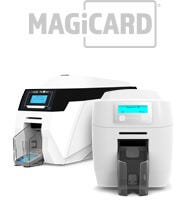ID Card Machines
Get a Free Needs
Analysis
How many IDs will you print per year
Laminating ID Card Printing Machines
ID card machines are used to print, encode, and laminate ID cards for schools, retail programs, businesses, and more. ID printer machines come in a wide range of styles and prices.
What are Laminating ID Card Machines?
Laminating ID card printing machines are ID printers that automatically laminate the ID card as it passes through the printer. The benefits of a card lamination machine include adding an extra layer of protection to ID cards as well as a more professional look. Businesses, schools and other industrial facilities often require lamination as part of their card program. This keeps IDs safer from everyday wear and tear and allows them to last longer.
How Were Laminated Cards Made Before Printers?
Before ID card machines became popular, the simplest and least expensive option to create ID cards was the laminating machine also known as the cut-and-paste or film-based method. This involved taking a person's photo, cutting it out, then laminating it to a card-sized piece of paper containing the person's data.
The process requires several manual steps:
- Take a photograph
- Type or print information about the card holder on a piece of paper or plastic such as teslin
- Paste the photograph on the the card
- Slip the paper card between 2 pieces of plastic
- Roll the plastic and card between the 2 rollers of the laminator to bond the plastic layers to the card and to each other
The process was then simplified by using a digital camera to print a photo directly on the paper with an inkjet printer. That method was also time-consuming but inexpensive, and until recently was appropriate for organizations issuing a small number of cards.
Why Use Laminating ID Card Printers?
The cut-and-paste lamination method has been replaced since the development of small and user-friendly ID printer machines that print directly onto plastic PVC cards. They typically use a dye sublimation process or thermal resin transfer process to adhere the color and other overlaminates to the card. The resulting ID card is much more professional and durable resulting in better looking IDs that last longer. Additionally, It is easy to encode information on the card with a magnetic stripe or bar code. Many dye-sub ID card printing machines will print directly onto intelligent cards such as smart cards or proximity cards. This makes it easy to integrate the ID cards into other systems for access control, time-and-attendance, and other tracking.
Machines that read ID cards are bar code scanners, mag stripe readers, proximity card readers, and smart card readers. They all work the same way in their simplest applications, but they can become very complicated as the intelligence on the card is increased and the entire system becomes more complex. Bar codes and mag stripes are relatively inexpensive and anyone who has checked out of a grocery store is familiar with them.
But proximity cards and (contactless) smart cards offer 3 distinct advantages: 1) They allow storage of much more information 2) The information is more secure 3) They may be read at a greater distance from the reader. These advantages make them and the machines that produce them more expensive and the complex systems of which they are a part require greater training to administer. The ID card machine is a component of a more complex system, but the appropriate ID card software can make the integration and use of the ID card machine easier.
ID card lamination machines are perfect for organizations looking to print professional IDs for their members. Shop employee id card machines with lamination capabilities at AlphaCard.
Find the Right
ID Card Printer
Answer the questions below to
get a free recommendation!
Instant Help
![]() (800) 717-8080
(800) 717-8080
![]() Live Chat
Live Chat
TOP CARD PRINTERS
-
![Authentys Pro RT1 Retransfer ID Card Printer - Single or Dual Sided Printing]() Authentys Pro RT1 Retransfer ID Card Printer - Single or Dual Sided PrintingMSRP $3,995.00 Price $3,995.00
Authentys Pro RT1 Retransfer ID Card Printer - Single or Dual Sided PrintingMSRP $3,995.00 Price $3,995.00
Not sure how to choose
an ID card printer?
BROWSE ALL CATEGORIES

Get Help from an ID Expert
How many ID cards do you want to print per year?














